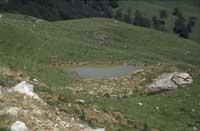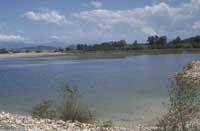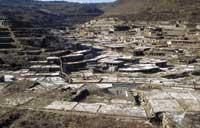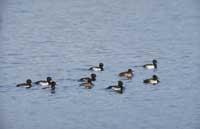Wetlands of the Basque Country (and XII): artificial wetlands

Among the wetlands of the Basque Country, to understand the importance of artificial wetlands, taking into account the surface of all wetlands, it should be noted that artificial wetlands represent between 60-70%. Therefore, although they are not traditionally considered in wetland conservation policies, at least from a quantitative point of view, their importance is undeniable, which should modify our view of these wetlands, at least in relation to those currently quite naturalized.
However, there is a wide variety and diversity of wetlands of artificial origin. On the one hand, the origin of the wetland, although all of them are of human origin, since the function of these water deposits totally conditions the physiognomy, morphology and evolution of the wetland. On the other hand, the location of artificial wetlands is also of vital importance, since their presence in the Euro-Siberian or Mediterranean region, in the mountains or in the valley, in the area of great escarpment or in the plain... directly influences biological and ecological processes. Finally, the current use of artificial wetlands should be considered, which totally conditions the evolution of the wetland and its possible naturalization.
Considering all these factors, artificial wetlands in the Basque Country can be divided into:
- Reservoirs.
- Waterfall ponds.
- Irrigation rafts.
- Mining or industrial lagoons.
- Saleras.
- Pools of parks or gardens.
Reservoirs

Reservoirs are artificial water reservoirs from dam construction in river valleys. These large volumes of water that aim to supply public, urban and industrial water, and in some cases irrigation, are the largest water areas that can be found in the Basque Country. However, due to the great depth and the steep margins that characterize the reservoirs, the water system is the same as the interaction between water and land, so they cannot be considered wetlands. In the back or edges of several reservoirs built only in plains or in valleys with little slope, the shallow depth allows to characterize the wetlands turning them over time into an environment of great biological and ecological richness.
However, the strong seasonal fluctuations in reservoirs are an obvious barrier to the development of wetland living communities, making it difficult to locate mature and structured wetlands in these places.
Among the reservoirs of the Basque Country that have undergone interesting naturalization processes, the Gamboa Uribarri, located in the Alavesa Plain, deserves special mention. After the swamp known as Mendixur, thanks to its low depth and its flat orography, in addition to the traditional vegetable belts of the wetlands, it allows to contemplate communities of abundant and varied vertebrates, especially aquatic birds.

Other reservoirs that have developed small wetlands on the margins are: In Gipuzkoa, the Urkulu de Aretxabaleta reservoir, the Orereta Landarbaso reservoir and the small Sariakola reservoir located in Orio-Aginaga; in Bizkaia, the Laukaritzko reservoir near Mungia and the El Regato de Barakaldo reservoir near Corkisa
Charcas
Scattered through our mountain ranges abound the small waterhole lagoons for cattle. These mountain lagoons are characterized by their small size, shallow depth and murky waters. In addition, due to the climate and, above all, to the entrances and exits of cattle, in these ponds the vegetation of the waters and margins is practically insignificant and, therefore, from the natural point of view, most of them lack value. However, they play an important role in the reproduction of mountain amphibians.
Irrigation tanks
These are mainly small water deposits in the Llanada Alavesa and La Rioja and the Ribera Navarra. In these irrigated areas, river flows are often not enough to supply the amount of water this type of crop requires, so many small ponds that collect rainwater have been built in low areas.

There are several built on springs or freatic outcrops, as well as those that collect the flow of small streams and cans, but all of them have been modified by man so that the accumulation of water is effective.
Although in these ponds, the strong seasonal fluctuations of water level constitute an obvious barrier to the development of vegetation, the low depth and favorable weather conditions have allowed many of them to have spectacular naturalization processes, becoming important natural elements of the landscape.
Among the irrigation rafts with high degree of naturalization are those of Añua and Argomaniz in the Alavesa Plain; El Prao de Laguardia in the Rioja Alavesa; Zilekieta lagoons in the Ibargoiti valley in Navarra and El Cardete in the Ribera de Navarra, near Tudela.
Mining and industrial rafts
We cannot fail to mention the ponds formed in abandoned quarries or in medianerías al aire libre, by accumulation of rainwater, or for obtaining the necessary water in certain industrial processes. In most of them, although abrupt edges or pollution prevent naturalization, there are in recent years interesting naturalization processes that must be taken into account.
Most of this type of ponds and wells are located in the mining area of Bizkaia, especially in the open pit mines abandoned in the mountains of Triano. Also noteworthy are the lagoons of Zolina and Morea, built by the company Potasa de Navarra of the Region of Pamplona, located in the quarry Etxerre de Basauri, the pond of Gurelesa in the neighborhood of Igara or the quarries near the town of Laño de Treviño.
Salinas

These structures designed to obtain salt from the waters of high salt concentration springs present a layer of shallow water for most of the year, so they can be classified within artificial wetlands.
In the salt flats, through small channels, the water from the salt springs is distributed in the portals, where it remains until its evaporation. Since water enters the portals until it evaporates, in these man-made structures a dynamic similar to that of endorheic wetlands occurs.
Most salt mines and salt springs are associated with the geological structures called diapiro that have been mentioned when analyzing karst wetlands, since the lithology of these unique geological structures makes the springs that appear in these media hypersaline.
In sandy areas, although human activity prevents the development of plant and animal communities typical of salt wetlands, around springs and streams, it is not difficult to observe some species of halophyte plants adapted to live in areas of high salinity.
The most significant example of this type of wetland is next to the Alava people of Añana Gesaltza. These saltworks, exploited since Roman times, are arranged on excavated land on the two banks of the valley and wooden structures constitute a set of great historical, cultural and natural value.
However, they are not the only ones. In Navarra we also have examples of this type of artificial wetlands, such as the salt flats of Jaitz, those of Ollo-Arteta or those of Ibargoiti.
Parks and gardens ponds

To conclude this brief review of the artificial wetlands of Euskal Herria, we will talk about the ponds created in recent years for the construction of new village parks and, above all, cities.
In some cases, because the construction of the park is framed in an environmental recovery project and in others, simply by the creation of an aquatic environment, the proliferation of artificial ponds in parks and gardens can be a sign of change in the conception of wetlands, since moving from the systematic destruction of wetlands as disadvantaged areas to health, to the artificial creation of new wetlands, shows that in our mentality something is changing.
In this way, we can conclude this series of articles that aimed to publicize the value, diversity and situation of the humid areas of the Basque Country. Gone is the work that has lasted almost eight years. During all these years I have had the opportunity to know wonderful and unknown spaces of Euskal Herria that I never imagined, and from this perspective I can affirm that the landscapes that contain water, besides being the most significant indicators of life, are landscapes of greater attraction.
In Euskal Herria we do not have large wetlands, but the richness and diversity of wetlands is very large. Unfortunately, this important part of our natural heritage is in a very precarious situation, since in recent decades many wet areas have disappeared completely and many others have remained in a very unfortunate situation.
In recent years, the development of lists of wetlands and the development of protection and restoration plans can be a sign of the will to end this destructive dynamic, but the destructive inertia that comes from a long time ago is very powerful, so the destruction or destruction of a wetland remains a daily fact. This situation is particularly worrying for small coastal wetlands: The marsh of Untxin de Socoa, the last marshlands of San Sebastian, the marsh of Motondo and Oribar in Orio, the marshes of Casa Campo in Deba, the marsh of Alleru in Ondarroa, the marsh of Ibarreta-Zuloko in Barakaldo...

All of them, like coastal wetlands, are areas of high value, but threatened by speculation and excessive development. As with all other environmental problems, most of us are very sensitive to the destruction of wetlands far from here (mangroves in the tropic area, large African estuaries...), but in the face of the intention of destroying the marsh, lagoon or peatlands that are next to our people or city, our answers are an indifference or a consideration that we must take in exchange for development.
It is known that a misunderstood development does not take into account natural heritage and only cares about immediate economic performance, but it is also increasingly accepted that this development model is endangering the very future of the human being. It is therefore necessary to bet on sustainable development and, in that sense, I believe that the conservation and recovery of wetlands that are authentic treasures of biodiversity must be priority objectives.





